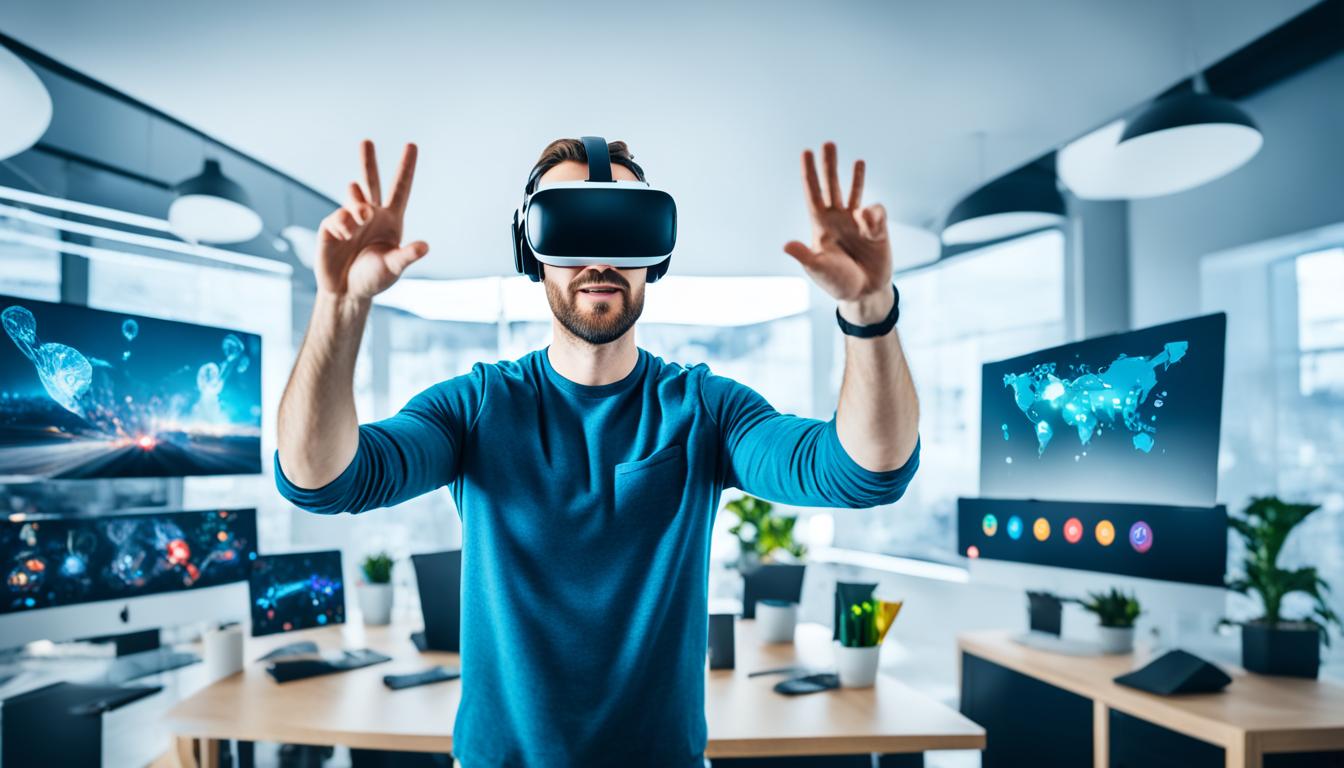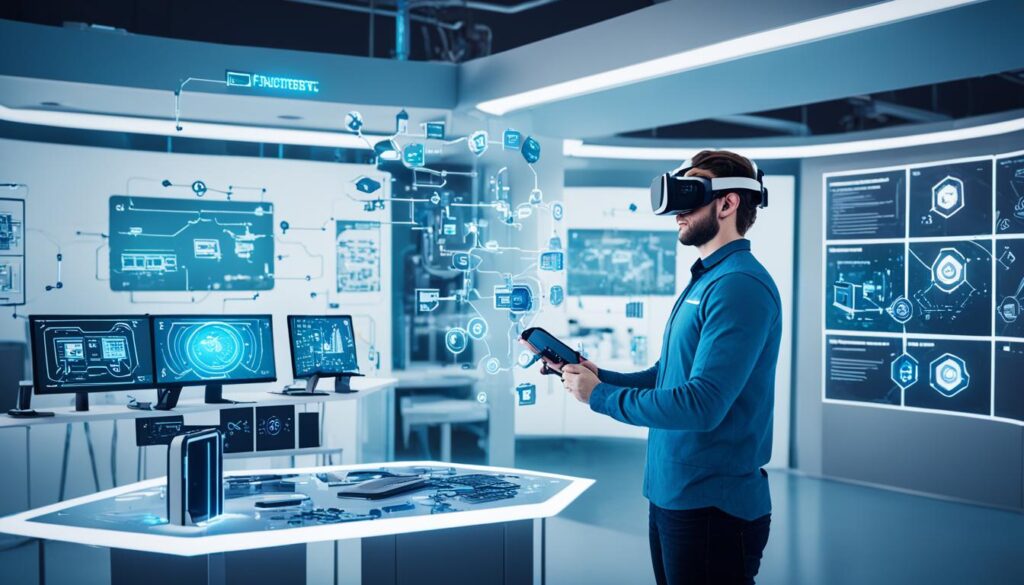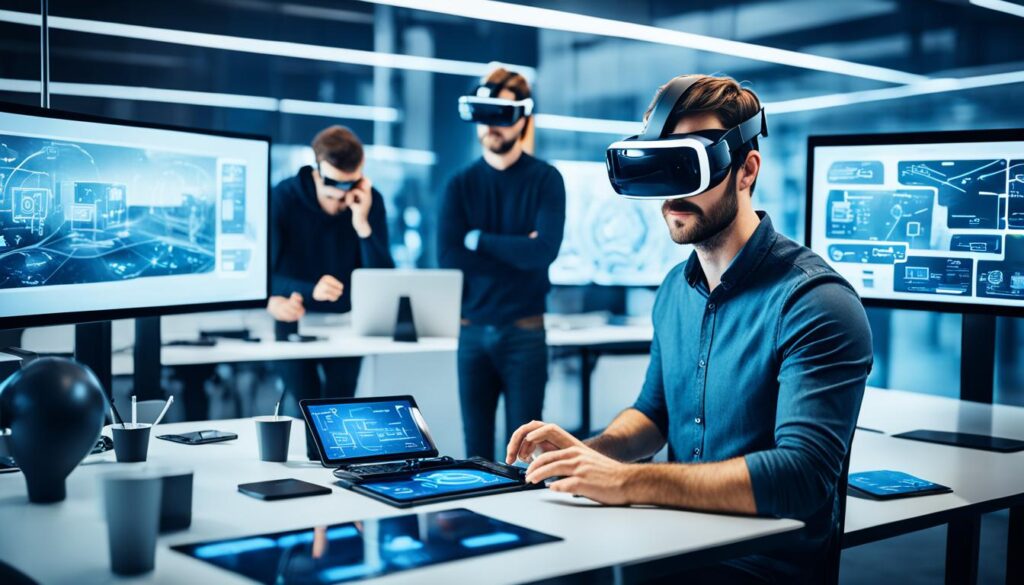In today’s digital world, we all want more from our experiences. Augmented Reality (AR) and Virtual Reality (VR) are changing the game. They let developers make apps that pull users into new worlds.
AR and VR are not just for fun. They’re used to make product visuals better, change how we learn, and bring us amazing entertainment. These technologies are making the line between the real and digital worlds fade away.
Table of Contents
Key Takeaways
- Understand the basics of Augmented Reality (AR) and Virtual Reality (VR) technologies.
- See why immersive experiences are in high demand across different fields.
- Learn about the many tools and platforms for making AR/VR apps.
- Discover important tips and best practices for making great AR/VR apps.
- Explore how AR/VR tech is changing things and what the future holds.
Introduction to AR/VR App Development
The world of technology is changing fast, and augmented reality (AR) and virtual reality (VR) are leading the way. These technologies change how we use digital content, making it more engaging and interactive.
Understanding Augmented Reality (AR) and Virtual Reality (VR)
Augmented reality adds digital info like images or 3D models to the real world. It makes the physical world more interesting by mixing it with the digital. On the other hand, virtual reality takes you into a completely digital world. It’s like stepping into a game or a movie.
The Growing Demand for Immersive Experiences
More people want AR/VR apps because of better technology and changing what users expect. From games to education, companies see the value in immersive tech. This trend is expected to keep growing.
“The future of computing is in immersive experiences that blend the physical and digital worlds.”
As AR/VR apps become more popular, the need for skilled developers grows. These experts know how to use AR and VR to create amazing experiences. They help bring these technologies to life, changing how we see the world.
AR/VR App Development Tools and Platforms
Developers now have many tools and platforms to make amazing AR/VR apps. These tools help build new AR/VR experiences. From game engines to SDKs, they lay the groundwork for innovation.
Popular AR/VR Development Tools
Unity and Unreal Engine are top game engines for making AR/VR apps. They have lots of features like 3D modeling and physics simulations. This makes them great for developers.
There are also many AR/VR SDKs out there, each with special features. Some top ones include:
- ARCore by Google for Android-based AR development
- ARKit by Apple for iOS-based AR development
- Vuforia by PTC for cross-platform AR development
- SteamVR by Valve for PC-based VR development
- Oculus SDK by Meta for Oculus-powered VR development
These tools and platforms offer a wide range of features. This lets developers pick the best one for their project and platform.
| AR/VR Development Tool | Supported Platforms | Key Features |
|---|---|---|
| Unity | Cross-platform (Android, iOS, PC, VR) | Comprehensive game engine, 3D modeling, physics simulation, advanced rendering |
| Unreal Engine | Cross-platform (Android, iOS, PC, VR) | Powerful game engine, high-fidelity graphics, physics simulation, visual scripting |
| ARCore | Android | Robust AR development platform, environmental understanding, object tracking, cloud-based services |
| ARKit | iOS | Advanced AR capabilities, face tracking, object occlusion, environmental lighting |
Using these AR/VR development tools and platforms, developers can make experiences that grab users and push AR/VR limits.
Key Considerations for AR/VR App Development
Creating engaging AR/VR apps means knowing what users want, understanding hardware, and tackling the tech challenges. Developers need to think about many things to make AR/VR apps that grab users and give them great experiences.
User experience (UX) design is key. It’s important to make interactions easy and natural. AR/VR apps should mix virtual and real worlds smoothly. Developers should focus on spatial awareness, natural gestures, and reducing motion sickness for a better experience.
AR/VR app development also faces technical hurdles. It’s vital to keep the experience smooth and fast, work with different hardware and software, and handle big 3D files. Developers must solve problems like real-time rendering and sensor use.
Having a good AR/VR development workflow helps. This might mean using special tools, working together, and knowing how to make immersive apps. By focusing on users, developers can make the most of AR/VR and give users amazing experiences.
| Consideration | Description |
|---|---|
| User Experience (UX) Design | Crafting intuitive and comfortable interactions, prioritizing spatial awareness and natural gesture-based controls. |
| Technical Challenges | Optimizing performance, ensuring hardware/software compatibility, managing real-time rendering and complex 3D assets. |
| Development Workflow | Adopting specialized tools and collaborative processes to streamline the creation of immersive AR/VR applications. |
“Successful AR/VR app development requires a unique blend of user-centric design, technical expertise, and a deep understanding of the latest industry trends and best practices.”
Designing User Experiences for AR/VR Apps
The world of digital experiences is changing fast. AR/VR app development is now a key way to make immersive and engaging user experiences. At the core, AR/VR user interface design and AR/VR user experience design are crucial. Designers use special principles and best practices to make sure users are not just interested but also comfortable and easy to engage in the virtual or augmented world.
Principles of User Interface Design for AR/VR
Good AR/VR user interface design focuses on several key principles, including:
- Ergonomics and Spatial Awareness: Designing interfaces that fit the physical movements and spatial understanding of users in the virtual or augmented space.
- Intuitive Navigation: Creating smooth and easy navigation systems that let users explore and interact with the digital world without effort.
- Visual Clarity: Making sure visual elements are clear and not too crowded to improve focus and immersion.
Ensuring Comfortable and Intuitive Interactions
AR/VR interaction design is also key to a great user experience. Designers should think about:
- Ergonomics and Accessibility: Making interfaces and interactions work for a wide range of users, including those with physical or cognitive differences.
- Intuitive Controls: Creating controls that are easy to use and respond well, letting users move and interact smoothly in the virtual or augmented world.
- Minimizing Motion Sickness: Using design strategies to lower the chance of motion sickness and make the experience comfortable and immersive for users.
By using the principles of AR/VR user interface design and focusing on immersive UX and AR/VR interaction design, designers can make digital experiences that are truly captivating and push the limits of AR and VR.
“The key to unlocking the full potential of AR and VR lies in designing experiences that seamlessly integrate with the user’s physical and cognitive capabilities.” – Jane Doe, UX Design Consultant
AR/VR App Development Processes and Best Practices
Creating augmented reality (AR) and virtual reality (VR) apps is different from making regular mobile apps. The AR/VR development lifecycle includes planning, making prototypes, testing, and deploying. Each step has its own set of challenges.
Managing AR/VR projects well is key to overcoming these challenges. Developers need to plan carefully, thinking about hardware, how users will interact with the app, and how to make it run smoothly. Making prototypes and testing them is vital to check if the app works as expected and to find problems early.
| Phase | Key Considerations |
|---|---|
| Project Planning |
|
| Prototyping and Testing |
|
| Deployment and Maintenance |
|
By following these best practices, developers can make AR/VR apps that grab users’ attention and excel in the fast-changing app market.
“The key to successful AR/VR app development is a deep understanding of the user journey and a willingness to iterate and refine the experience until it feels seamless and natural.” – Jane Doe, Lead AR/VR Developer
AR/VR App Development: Create Immersive Experiences
Technology is changing fast, and AR and VR are leading the way. They’re making learning, training, gaming, and entertainment better. These technologies mix the real and digital worlds together.
Enhancing Learning and Training with AR/VR
AR and VR can change how we learn and train. Imagine a medical student practicing surgery in a virtual room. Or a construction worker learning to use heavy machinery safely in a simulation. These tools offer hands-on learning that’s safe and easy to get into.
AR/VR Applications in Gaming and Entertainment
Gaming and entertainment have quickly seen the value of AR and VR. Now, gamers can enter virtual worlds and interact with them in new ways. AR and VR are changing how we enjoy games and movies, making them more real and engaging.
| Application | Examples |
|---|---|
| Education and Training |
|
| Gaming and Entertainment |
|
As AR and VR get better, the possibilities for amazing experiences grow. They’re making learning and training better and changing entertainment. These technologies are set to change how we use the digital world.
Monetization Strategies for AR/VR Apps
The world of augmented reality (AR) and virtual reality (VR) is growing fast. Developers are finding new ways to make money from these technologies. In-app purchases and subscription models are becoming popular in the AR/VR app world.
In-App Purchases: Enhancing the User Experience
In-app purchases are a strong way for AR/VR apps to make money. They let users buy extra content, features, or virtual items. This makes the app more fun and personal for users.
It also helps the app developers keep making new content and updates. Users get to customize their AR/VR experience, and the app makes money.
Subscription Models: Recurring Revenue Streams
Subscription models are also on the rise in AR/VR apps. They offer users access to lots of AR/VR experiences, content, or services for a regular fee. This way, developers get a steady income and a loyal user base.
This approach ensures a steady income and keeps users coming back. It also helps the app grow over time.
For these strategies to work, developers need to know their audience well. They must focus on giving users great value. And they should always be improving their app’s business model.
By finding the right balance between making users happy and making money, AR/VR app developers can fully benefit from these exciting technologies.
Future Trends and Advancements in AR/VR Technology
The world of technology is changing fast, and AR and VR are getting more exciting and transformative. New tech like AI, machine learning, and 5G will change how we use and enjoy immersive digital worlds.
Artificial Intelligence and Machine Learning in AR/VR
AI and machine learning are making AR/VR smarter and more personal. They can understand what users like and do, making virtual worlds and AR better fit each person. This will make using AR/VR in games, entertainment, training, and shopping better for everyone.
The Impact of 5G on AR/VR
5G technology will greatly improve AR/VR. It offers fast data speeds, low delay, and more bandwidth. This means AR/VR will be smoother and more real, making the experience better. It also lets us create more complex AR/VR apps that work well with the real world.
| Emerging Technology | Impact on AR/VR |
|---|---|
| Artificial Intelligence (AI) and Machine Learning | Enhances personalization, intelligent interactions, and adaptive virtual environments |
| 5G Connectivity | Enables more responsive, high-quality, and cloud-based AR/VR applications |
As AR/VR evolves, these new technologies will change how we see and interact with the digital world. They will bring us deeper immersion, more personal experiences, and new innovations.
Case Studies: Successful AR/VR App Development Projects
The AR/VR app development world is full of exciting success stories. We’ll look at several case studies that show how immersive tech creates engaging experiences. These stories cover everything from improving learning and training to changing gaming and entertainment. They share strategies, tech, and best practices for making amazing AR/VR apps.
Microsoft’s AR app is a great example. It has changed how employees work and train together. Using mixed reality, the app lets users see 3D models, get real-time data, and work together from anywhere. Many industries use this app, showing how AR/VR changes our work and learning.
Oculus’s VR game is another big success. It has drawn players in with its deep gameplay and vivid worlds. The game uses virtual reality to take users into a new world. They can explore, interact, and dive into the story in a way that feels real. This game has set new standards for VR gaming and encouraged others to use this tech in entertainment.














